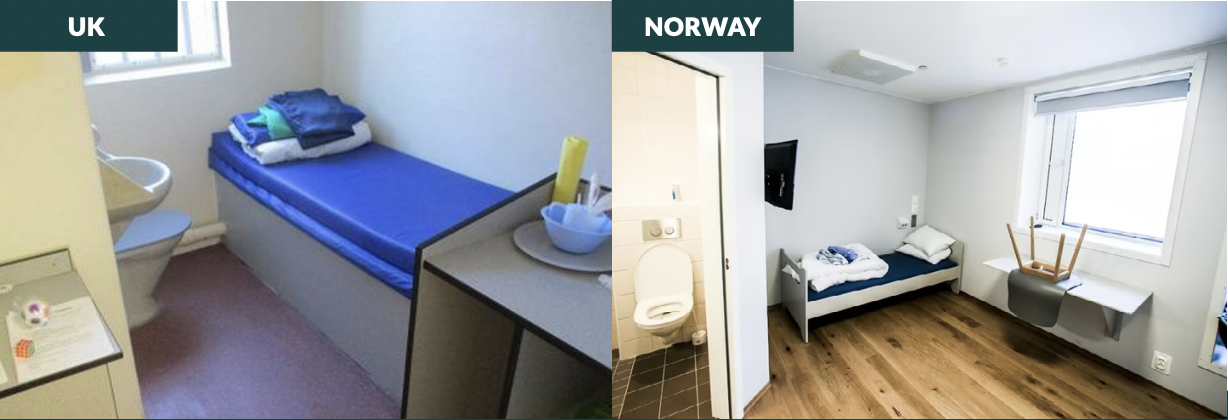
In Autumn 1994, five-year-old Silje Marie Redergård was found dead outside her home in Trondheim, Norway. Three children between four and six were blamed for the murder. A year previously, a similar case had unfolded in England. Two-year-old James Patrick Bulger was murdered by two 10-year-olds.Both cases present shocking examples of children committing serious violent offences, yet their subsequent stories share little commonality.
The General Comment No. 24 (2019) on Children’s Rights in the Child Justice System (UN Convention on the Rights of the Child) recommends a minimum age of criminal responsibility (MACR) of at least 14 years. As the MACR is 15 years in Norway, the children in the Redergård case were not held criminally responsible and thus not charged with the murder. As part of this, they were shielded from the public and their identities were never revealed to the media. In the UK, the MACR is just 10 years, which is amongst the lowest in Europe. The children in the Bulger case were held in secure detention for nine months before being tried in an adult court, and sentenced to a Secure Children’s Home, where they served eight years. The story spread around the world. The two children were subjected to extreme hostility from the public and the media throughout their trial and detention, even though children’s identities should be protected from potentially dangerous publicity.
It has been almost 30 years since the events surrounding the Bulger case. So, we wonder - has the UK become better at dealing with young offenders who commit serious crimes?
In 2019, when he was just a Parliamentary Under-Secretary of State for Justice, Edward Argar MP, opined that the UK had made “significant progress over the past decade” including publishing the “Standards for Children in the Youth Justice System”. He is now the Minister responsible in the same department for Victims and Sentencing. He has a broad brief in areas which clearly need urgent attention.
The number of incarcerated young people in the UK has decreased in the last three decades. However according to a UNICEF report from 2020, the juvenile justice system continuously fails to preserve children’s rights and keep them safe. To illustrate this, in August 2022, 493 children between ten and 18 years are still institutionalized in England and Wales, with ethnic minorities being largely overrepresented with a ratio of up to 1:4 (Youth Justice Statistics: 2018 to 2019, Board3). School exclusions have also increased, as well as the use of segregation and solitary confinement in custody. Also, legal professionals continue to lack specific knowledge of youth justice and children’s rights. This is alarming. An increase in the number of restraints or segregation in custody or care at one stage shown an alarming rise.4 More recently, in 2020, two of three Secure Training Centres were still deemed inadequate due to serious concerns related to untrained use of force and restraints, levels of violence, poor leadership, education, and healthcare provision.5
How could the UK improve its practices with young offenders who committed serious crimes?
To answer this question, it may be helpful to turn to the UN Convention on the Rights of the Child and recommendations by UNICEF. UN Article 376 acknowledges that children and young people (anyone under the age of 18) are more vulnerable and possess different needs than adults due to their level of development. Therefore, when such a young person commits a crime, the arrest, detention, or imprisonment should only be used as a measure of last resort and for the shortest appropriate time. If a child is arrested, UN Article 37 further states that they must be separated from adult prisoners, treated with humanity and respect, and in a manner that considers the specific age of the child. Whilst the UK clearly recognises these principles, all is not yet as it should be.
A recent evaluation of the British Criminal Justice System (CJS) by UNICEF recommends the UK to eliminate inhumane practices (such as solitary confinement, tasers, and spit-hoods), to increase the MACR and to preserve the young offenders’ anonymity7.
All jurisdictions will encounter tension between the above-mentioned UN Convention and criminal justice principles, such as retribution, deterrence, and community safety. Taking the best interests of the child from a developmental perspective seriously can be at odds with traditional ideas of detention and punishment of criminal justice.
So, can the UK learn from its neighbours in the North in order to improve the handling of children and young people who have committed serious crimes? When comparing the UK and the Norwegian systems, major differences become apparent. One example relates to the fundamental principles that underly the jurisdictions. When custody at any age is seen as the only solution, the UK appears to favour principles such as retribution and deterrence, and the need for reform during time spent in custody appears less of a priority. In contrast, Norway only allows punishment in form of restricting a person’s liberty, meaning that no other rights can be removed by the sentencing court. There, the guiding principles are normality and progression. That is, life inside the institution should resemble life outside as much as possible, and security levels in detention should be reduced gradually.
Even though the general number of sentenced children and young persons in the UK has decreased by 80% in the last decade, the proportion of custodial sentences in comparison to non-custodial sentences did not change over this period.8 Even more so, the length of sentences for young persons for indictable offences has been increasing over the last four years. We see today that children and young people convicted for indictable offences receive five months longer on average compared to ten years ago. Being deprived of family and friends will make resocialization more difficult. Indeed, two-thirds of young people surveyed said it was not easy for their friends and families to visit while in custody, further closing them off from their ordinary lives. Unfortunately, recent cases from the UK suggest that imprisonment may still not be fully respected as a “last resort”. Serious questions are raised elsewhere in this magazine by two experienced and recently retired senior UK Circuit Judges about how courts in England and Wales sentence in cases of homicide, and on the lack of positive evidence of deterrence in the use of custody9.
In Norway, imprisonment of young people is seen as extremely negative in terms of healthy development. In the last decades, it has been a clear political goal to reduce the use of prison punishment for the youngest in society. Since the 2000s, the number of convicted young people has reduced notably, and much greater focus is given to what’s in their best interest. It would be wrong to fail to acknowledge that there has been a marked reduction in the number of young people in England and Wales being sent to young offender institutions. Despite this, we suggest, there remains a difference of approach, and perhaps a need for greater legislative imagination. Instead of sentencing young people to prison as a last resort, the relevant law in Norway states that prison should only be used as an alternative for when there is a specific need for it. Today, only a few young people serve a prison sentence in Norway. Instead of prison, alternative strategies are put in place.
For example, since 2014, two new penal sentences for juveniles have been administered by the National Mediation Service. Target groups are offenders between 15-18 years old at risk of recidivism and in need of follow-up. Alternatives to prison or community sentences are the so-called Youth Punishment (sex offences and robbery), which may last from six months up to a maximum of three years, and the Youth Follow-up (drug offences and violence), which may last from four months up to a maximum of one year. The contents of both these penal sentences have the same three components:
1. Restorative meetings/processes with the victims or others affected by the offence,
2. Tailor-made youth action plans for the period of the sentence, and
3. Signing and fulfilling this plan, supervised by a cross-sectorial follow-up team. During this time, the youth will continue to live with their families in society. If a penal case is successfully mediated and a signed agreement is fulfilled, the case is closed. More importantly, the case will not be visible on the offender’s criminal record, and after two years, if the person did not commit another offense, the case must be expunged from their criminal record.
However, young people do receive custodial sentences in Norway, but these are limited to the most serious offences. In total, two institutions hold eight available places for youth (four for each). During the last few years, there has been an average of four to six young people per year serving prison sentences in Norway. Further, the conditions look very different than in the UK. The two specific institutions that were established to receive young offenders are characterised by a very high staff-prisoner ratio, and a cross-professional approach. For example, a 15-year-old girl serving a sentence for murder has a group of six professionals looking after her. Educational workers, psychologists, and healthcare workers collaborate closely to ensure that the youth receive the help and support they need. Importantly, the places are not categorized as prison cells, but rather as units.
One way to shed light on the success of the Norwegian as compared with the UK approach to young offenders is to look at recidivism rates. In the UK, young offenders released from custody had the highest reoffending rate compared to those who received non-custodial sentences, indicating that harsher punishment failed to realise a central purpose of sentencing (see Youth Justice Statistics: 2020 to 202110). In 2022, a report commissioned by the Norwegian Ministry of Justice and Public Security concluded that life quality (e.g., completeness of education, health, and work opportunities) decreases as the harshness of punishment increases. Currently, Norway does not have enough data available to conduct statistical analyses on recidivism rates of young people. One reason for the low numbers is that most young offenders usually received only one sentence during their youth. Thus, drawing precise comparative conclusions on the consequences for the young offenders’ future lives is not feasible. However, children and young people who are punished by Youth Punishment and Youth Follow-Up do receive close follow-ups and cross-professional approaches, with a focus on rehabilitation instead of incarceration. In comparison to custodial sentences, this approach will surely set the stage for the young person to better succeed later in life. For example, young offenders who are given sentences such as Youth Punishment are more likely to receive education and get employed later.

UK: www.examinerlive.co.uk/news/local-news/wetherby-young-offender-institution-slammed-23410363
Norway: https://www.aftenposten.no/norge/i/kX5v/ungdomsfengselet-i-bergen-her-skal-15-aaringen-sone-straffen
Today, we suggest that the UK cannot claim to be adhering fully to either the UN Child Convention or the UNICEF suggestions on the treatment of children or young people who commit crimes. In contrast, Norway adheres to these guidelines in a much more evident manner. At least we can say with certainty that harsher punishment does not improve the life circumstances young offenders are struggling with. Given the high recidivism numbers in the UK alone – putting aside the high costs for the child’s well-being, there is much improvement to be made. The Norwegian approach seems more promising. There might be more to be learned from examining systems in other countries who have managed to get away from the kind of rhetoric that hinders real reform. While we may never be able to stop young people from committing violent crimes, we can influence how they are treated. How we respond to them may just make the difference in whether they will come out of the experience, and live a healthy fulfilling life, or whether they become entrenched in the system, destined to continue their criminal journey. Improving the way the criminal justice system in the UK deals with its young offenders is of utmost importance. Our view is that the UK might do well to use Norway as a good model for necessary adjustments in order to support troubled children and young people, to make them feel like they are equally worthy of returning into society and give them the opportunity to improve and become valued members of society. We also suggest that by so doing the UK might even save lives and decrease the ultimate damage to society caused by young offenders.
References:
3 https://www.gov.uk/government/statistics/youth-justice-statistics-2018-to-2019
5 See too https://publications.parliament.uk/pa/cm5803/cmselect/cmpubacc/30/report.html
8 https://www.gov.uk/government/statistics/youth-justice-statistics-2020-to-2021
9 See articles in this edition by recently retired Old Bailey judges, His Honour Nick Cooke KC and Her Honour Wendy Joseph KC.
10 https://www.gov.uk/government/statistics/youth-justice-statistics-2020-to-2021

Thea Johsefine Austevik

Lara Schwarz